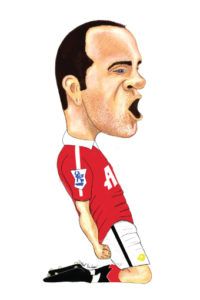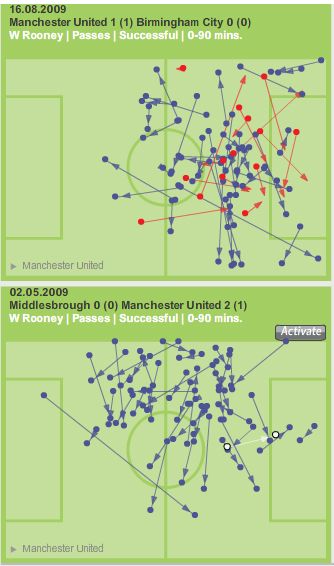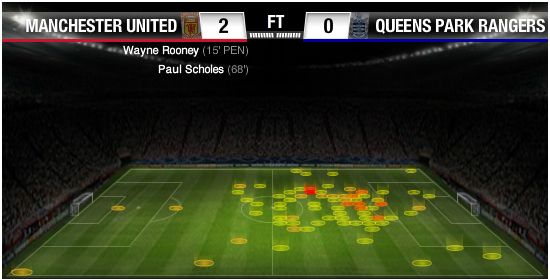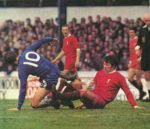It may seem like a long time ago when an 18 year old Wayne Rooney swapped the Merseyside blue shirt for the Manchester red. Eight years on, he is the most important member of the Manchester United squad – as important as Cristiano Ronaldo was, if not more. Temperamental, dynamic, talisman – these are the terms that are frequently used to describe the English forward, and rightly so. In the age of versatile forwards who can play across the front line and offer you a plethora of goals, two names stand out – Lionel Messi and Cristiano Ronaldo. If one were asked to name a third player, who comes close to the duo in terms of talent, effectiveness and importance to their respective teams, it would have to be Wayne Rooney, around whom English champions Manchester United’s game seems to revolve around.
For a world class striker, scoring 143 goals and providing 65 assists in about 6 seasons seems a good strike rate, if not spectacular. But to do the same playing in a withdrawn role, and as a defensive forward on the left, is what makes Wayne Rooney a phenomenon. To say that he has brought in a fresh perspective to how forwards are viewed would not be off the mark. He cannot be termed a centre forward, he doesn’t quite play the False 9 role, he’s not a False 10 either. In fact, if one were to compare him to another player, one would have to go back to the late 80s to find someone similar – Ruud Gullit, whose versatility and completeness were well exploited by Arrigo Sacchi, under whom he played as a centre forward, a support striker, an attacking midfielder, or sometimes even as a central midfielder. In comparison, Wayne Rooney has been used as a lone striker, a support striker, an attacking midfielder behind the striker, left forward, and the latest – a playmaking forward who drops deep into the midfield.
Over the years – A recap
A quick look at Manchester United circa 2006-09 will see Wayne Rooney swapping his favoured Support Striker position for a Left Forward position to make better use of Cristiano Ronaldo’s goal-scoring prowess. The following heat maps, taken from the Champions League games – against Roma in 2007-08, and against Arsenal in 2008-09 – will show the same.
Against Arsenal, a year later, the roles were reversed. Wayne Rooney was deployed on the left as a defensive forward, while Cristiano Ronaldo’s goal-scoring prowess made him an automatic choice for the Centre Forward role.
Quickly moving on to the crux of his article, his passing has seen changes over the period of time too. When he played as a left forward, he would, more often than not, look to square the ball, holding it up and pulling players to himself and releasing the free player in the centre. Once Cristiano Ronaldo moved to Real Madrid, Rooney played through the centre, back in his role as a support striker, always looking to play a through ball to the centre forward, which was more often than not Dimitar Berbatov – who often interchanged positions with Wayne Rooney, allowing him to surge into the box to make use of his shooting and heading skills.
Even then, the important aspect to note is how he would always look for a killer ball into the box, which meant that his pass completion rate was low, which was acceptable for a support striker. But it also meant that his passing ability, which he possessed in abundance, was not made complete use of. The prime reason for this was the absence of a proper striker – with Dimitar Berbatov blowing hot and cold – meaning Wayne Rooney was also entrusted with the responsibility of being the main goal-scoring threat for Manchester United.
Changing times, changing roles
The earliest suggestion of his transformation to a playmaking forward perhaps came in the 2010-11 season when, after the transfer row and consequently being sidelined through injury, Wayne Rooney returned to the team to partner Dimitar Berbatov, who was having his best season in a Manchester United shirt. If the previous season saw him playing ahead of Berbatov, the 2010-11 season saw him play behind him. With every passing game, it seemed like he was more and more comfortable with a role that allowed him to make use of his natural playmaking ability. He passed more, and he found the target more often. The tendency to look for the killer through ball all the time was slowly making way for a calm, composed demeanour a la Paul Scholes. He was still scoring goals – but he was influencing games more than ever before, with his possession play, even when he was not scoring. Wayne Rooney was slowly becoming all that Manchester United needed at the moment – someone who could create down the middle, feed balls to the wingers and finish the chances as they presented themselves – and more.
The new look Wayne Rooney – Forward or Midfielder?
The start to the 2011-12 Premier League season saw the academy lad Danny Welbeck partnering Wayne Rooney up front. Welbeck’s off the ball movement and one-touch play meant that Wayne Rooney could drop deeper into the midfield to ease the lack of creativity displayed by the English champions in the early part of the season. In fact, he was even deployed as a Central Midfielder in the league game against Sunderland – and partnering Darren Fletcher, he did a good job at it too! From the following heat maps, one may see that even while playing as a natural forward, Rooney makes a lot of touches in the midfield and wide areas of the pitch, which perfectly complements his free role. And when he played as a midfielder, he moved ahead a lot, working the ball into the box and creating opportunity for himself and others.
As the season progressed, Rooney was seen dropping more and more into the midfield, helping out Michael Carrick with retention of possession in the absence of Darren Fletcher – who was Manchester United’s best midfielder in the earlier two seasons. If the fans hadn’t forgiven him already for holding the club hostage over a new deal, Wayne Rooney showed that he was worth every last penny Manchester United was paying him – always stepping up when the club needed an inspiration, always wearing his heart on his sleeve – never afraid to get stuck in, never afraid to take on his man, never afraid to put his body on the line – always creating chances and scoring a lot of goals himself. He was back to being the heart and soul of the Manchester United team – the ever so talismanic English prodigy slowly blossoming into the most complete player of his generation.
Dissecting the transformation – One pass at a time
What aided the transformation was something nobody could foresee. The Wayne Rooney of old – the temperamental, abusive, frustrated, indecisive Rooney – was gone. And it was replaced by a manager’s dream – an inspirational, determined talisman, who is calm, composed, and above all valued his team over himself. He has not picked up a caution over 31 matches this season in Premier League – and that is saying a lot, considering his earlier streak was a mere 9 matches. This allowed Rooney to play an auxiliary playmaker, making passes from deep or moving ahead playing one-twos with Ashley Young or Danny Welbeck.
In Wayne Rooney, Michael Carrick found an able supporter, who was content with keeping the possession, and slowing the game down when the others needed a breather. He could also play long passes, but the frequency of those were coming down, as Manchester United dominated the other teams in Premier League by keeping possession in the midfield and moving the ball forward quickly on the break. It is a testimony to Rooney’s ability that the Manchester United midfield, which was missing a genuine playmaker before Paul Scholes’ return was hardly ever overrun in the Premier League.
The following video clip, from the Manchester United vs Blackburn match illustrates the point of a playmaking forward better – if one were to look at the positions taken up by Wayne Rooney, one would find that he dropped deep into his own half, making himself always available for a pass, and always finding an unmarked man to pass to. What one may not realise is that it has been a common occurrence this season, that is the way he has always played.
Stats Centre – What do they say?
While his offensive stats are particularly impressive – 26 goals and 4 assists in 31 games so far, taking 4.6 shots per game on average, a new aspect to his overall game has come into light this season. He has been called offside only twice so far, and has made only 46 key passes – meaning he was playing deeper than usual. But what has truly been magnificent is how his passing and defensive stats mirror that of a midfield playmaker. He made an average of 51 passes – which include 5.5 long balls per game, with 81 percent of them finding their target. He has also made 18 tackles, 15 interceptions, 19 clearances and blocked 6 shots – the most for any forward in Premier League.
Wayne Rooney’s overall involvement in the game has gone up significantly this season – most of his touches are outside the penalty box, and mostly in the advanced midfield position. For example, against QPR at home, he made a total of 5 touches inside the penalty box, one of which was to score off a penalty. While this may suggest that he might have been playing a False 9 role, it couldn’t be further from the truth. While he may not possess the dribbling ability characteristic of a False 9, he makes up for it – and more – with his decisive passing and his ability to dictate the tempo of the game, pulling strings from a deeper position.
Wayne Rooney – More than a complete forward?
The future looks bright for Wayne Rooney and Manchester United. It seems like he has broken free of the shackles that stopped him from fulfilling his early promise, and is well on his way to becoming one of the most complete players ever. His versatility has given Sir Alex Ferguson the freedom to pair him up with Danny Welbeck – a mobile forward or Javier Hernandez – a fox in the box. While George Best believed that he was born to entertain, and Eric Cantona believed that he was a classy artist, Wayne Rooney has no such airs. He is closer to an English labourer than to a French artist – someone who doesn’t mind getting dirty, but at the same time believes he is second to none. It may not be out of scope to suggest that someday, when he is well past his peak and his legs can’t last the duress of the forward role, he will settle down as a holding midfielder, frustrating the opponents with his passing and subtle movements, more keen on keeping the ball than bursting into the box in search of a goal.
In the era where football is becoming a specialist’s nightmare, Wayne Rooney seems like every manager’s dream player. While he may not have the magic of Lionel Messi or the explosiveness of Cristiano Ronaldo, he offers something to the team that nobody else does. Football does seem to be moving towards such kind of forwards – Marco Reus being one of them – who could double up as advanced playmakers, and put an odd tackle in. It is yet to be seen if Wayne Rooney remains the only one of his kind, or if he is the first one in the list of many. Whatever it may be, one thing is certain – the game of football would be lucky to have seen the likes of him.
Is Wayne Rooney the most complete player of his generation? Please leave your comments below. If you like the article, please share it with your friends who enjoy a good read.
Chalkboards courtesy: Guardian.co.uk, Heat maps courtesy: ESPN Soccernet.
This article first appeared on Sportskeeda
–Kiran Vr














Recent Comments